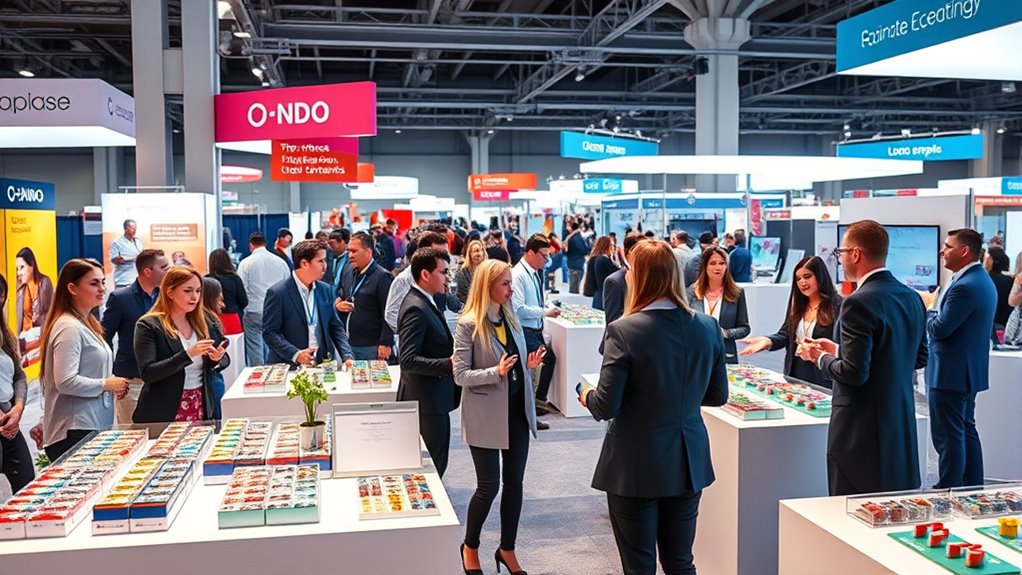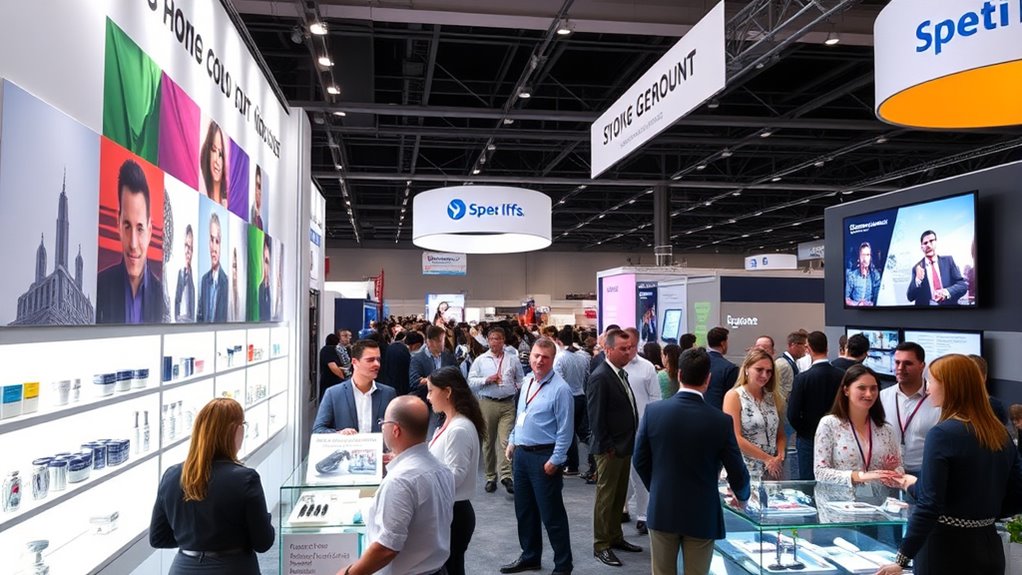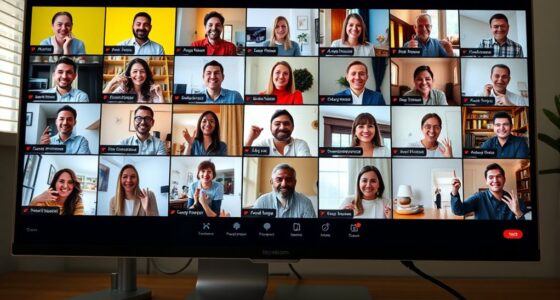To turn trade shows and pop-ups into profit machines, focus on strategic pricing that creates urgency and clearly shows value. Engage visitors with friendly, storytelling approaches and tailor your pitches to their needs. Incorporate hands-on demos or samples to build confidence and boost sales. Use eye-catching signage and displays to draw attention. Finally, follow up with contacts to create long-term relationships. Keep exploring these proven tactics to maximize your event success and revenue potential.
Key Takeaways
- Implement tiered pricing, bundle deals, and time-limited discounts to create urgency and boost sales.
- Engage visitors with personable interactions, storytelling, and active listening to build rapport.
- Incorporate demos, samples, and hands-on experiences to increase customer confidence and encourage purchases.
- Use strategic signage, compelling offers, and social proof to attract foot traffic and influence decisions.
- Collect contacts, follow up with personalized offers, and nurture ongoing relationships for sustained profitability.

Participating in trade shows and pop-up events offers valuable opportunities to grow your brand and boost sales, but success depends on your selling strategies. To maximize your efforts, you need to master effective pricing tactics and foster genuine customer engagement. Price plays a pivotal role in conversions; setting the right price can make or break a sale. Consider using tiered pricing, bundle deals, or limited-time discounts to create a sense of urgency and value. Don’t just rely on sticker prices—explain the benefits behind your pricing to justify costs and encourage impulse buys. Transparency builds trust, and when customers see the value you’re offering, they’re more likely to make a purchase.
Effective pricing strategies and genuine engagement boost trade show sales and build customer trust.
Customer engagement is equally essential. Your approach should be energetic and personable, making visitors feel welcomed and valued. Instead of simply listing product features, focus on storytelling that connects your products to customers’ needs and lifestyles. Ask open-ended questions to understand what they’re looking for and listen actively—this makes shoppers feel heard and appreciated. Demonstrate a genuine interest in their preferences, and tailor your pitch accordingly. Use eye contact, smile, and maintain an approachable demeanor; these small actions greatly increase the likelihood of closing a sale.
Another key to turning trade shows into profit machines is creating an interactive experience. Incorporate demos, samples, or quick tutorials that allow visitors to experience your products firsthand. When customers can see, touch, and try before buying, their confidence in your offerings grows. Pair this with effective upselling techniques—suggest complementary products or premium options that enhance their initial choice. This not only increases your average transaction size but also reinforces the value of your brand.
In addition, leverage your booth’s layout and signage to draw attention and guide traffic naturally. Use clear, compelling calls-to-action and highlight any special offers prominently. Social proof, such as testimonials or showcasing your bestsellers, can influence hesitant buyers. Remember, the goal is to create an inviting environment where potential customers feel comfortable asking questions and making decisions.
Finally, follow up after the event. Collect contact information and send personalized thank-yous or exclusive offers. Building relationships beyond the trade show can turn one-time visitors into loyal customers. Incorporating knowledge about holistic approaches to health and wellness can also help position your offerings as comprehensive solutions that resonate with customers seeking well-being. Consistent engagement through email or social media keeps your brand top of mind, encouraging repeat business. When you combine strategic pricing tactics with active customer engagement, you set the stage for trade shows and pop-ups to become powerful profit centers for your business.
Frequently Asked Questions
How Can I Measure ROI From Trade Shows Effectively?
To measure ROI from trade shows effectively, you need to focus on attribution models and data tracking. Set clear goals, like leads or sales, and use tracking tools to monitor how attendees interact with your booth and campaigns. By analyzing this data, you can see which efforts generate the most value. This approach helps you allocate resources wisely and improves your future trade show strategies for better ROI.
What Are the Best Ways to Attract Foot Traffic?
To attract foot traffic, you should focus on eye-catching signage that grabs attention from a distance and makes your booth stand out. Pair this with engaging demos that invite visitors to interact with your products or services. Use vibrant visuals, clear messaging, and live demonstrations to draw people in. Promoting special offers or contests can also increase interest. These strategies create a compelling experience that encourages passersby to stop and explore.
How Should I Follow up With Leads Post-Event?
Following up with leads is like tending to a garden—you need to do it promptly. Use personalized messaging to remind them of your conversation and their specific interests. Make your follow-up timely, ideally within 24-48 hours, to keep your brand fresh in their minds. This approach shows you’re attentive and committed, increasing your chances of turning leads into loyal customers. Consistent, genuine follow-up is the key to sealing the deal.
What Budget Should I Allocate for Trade Show Success?
When planning your trade show budget, start with clear budget planning based on your goals and expected ROI. Allocate funds for booth design, marketing, and travel. Don’t forget sponsorship opportunities—they can boost visibility and attract more leads. Be flexible, and track your expenses to guarantee you stay within your budget. Investing wisely in these areas maximizes your success and helps turn trade shows into profit machines.
How Can I Differentiate My Booth From Competitors?
To differentiate your booth from competitors, focus on creating a unique branding experience that captures attention immediately. Use bold, eye-catching visuals and a clear message that aligns with your brand identity. Incorporate interactive elements or demos to engage visitors actively. Consistent branding across all materials enhances visual appeal, making your booth memorable. By standing out visually and delivering a compelling message, you’ll attract more attendees and generate higher interest.
Conclusion
By applying these proven selling strategies, you can turn your trade shows and pop-ups into powerful profit machines. Remember, 80% of trade show attendees have buying authority, so engaging them effectively can boost your sales considerably. Stay confident, focus on authentic connections, and follow up promptly. With the right approach, you’ll not only attract more customers but also build lasting relationships that drive your business forward. Now’s the time to turn those opportunities into real profits!






